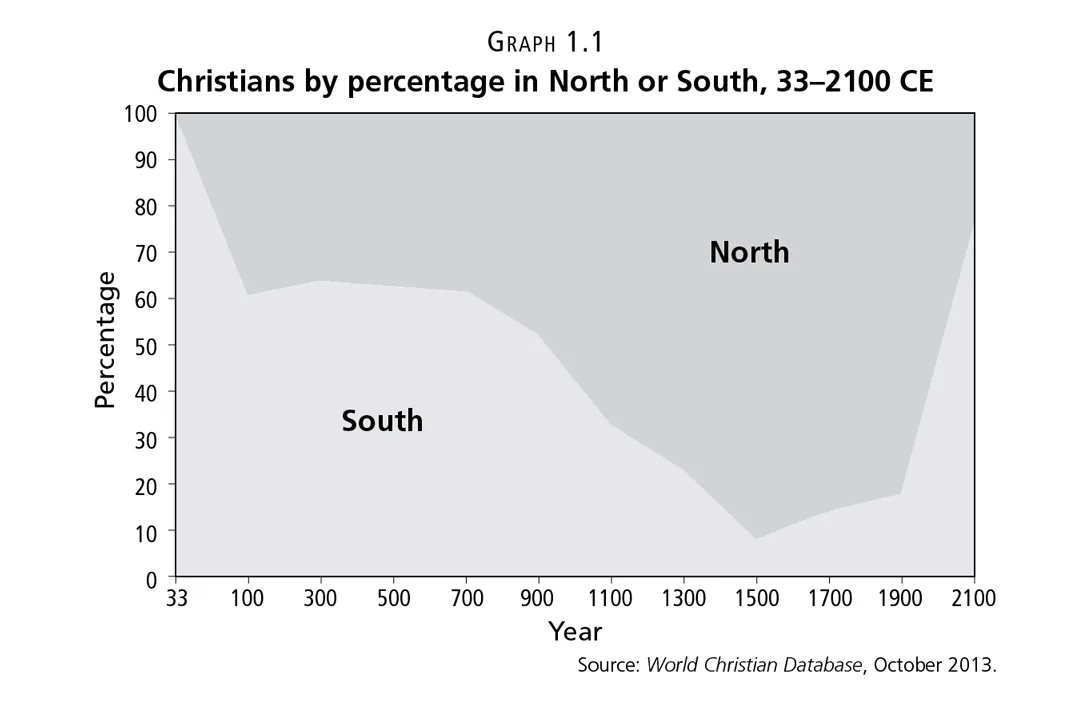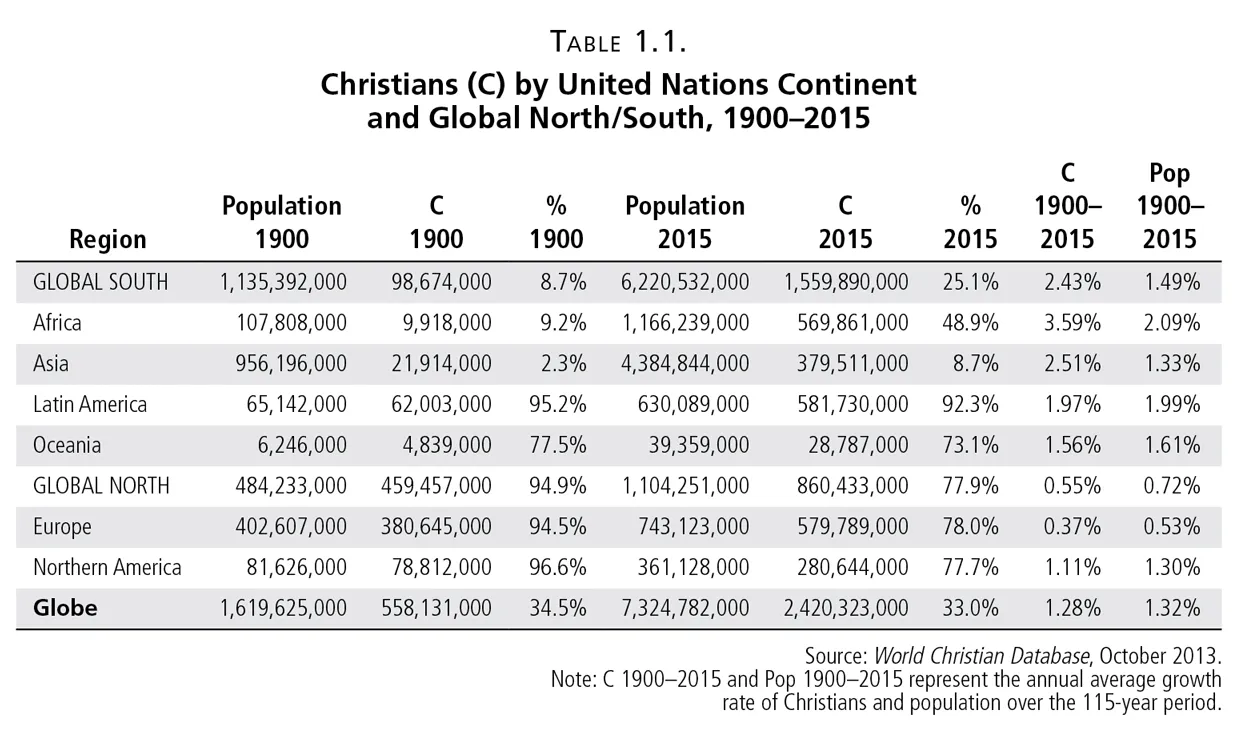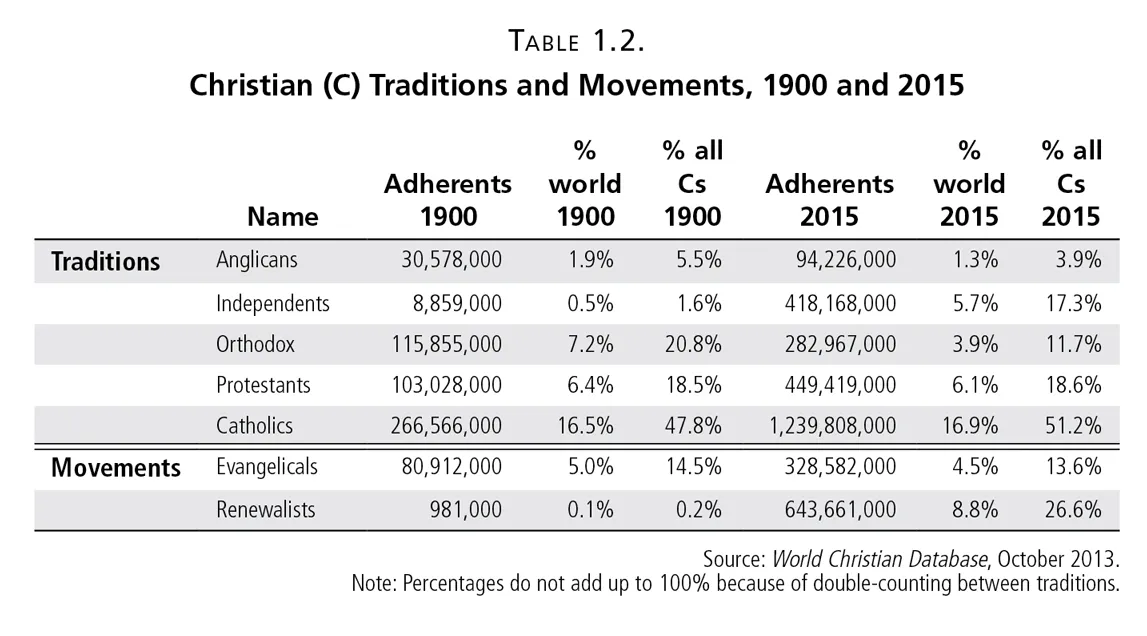
eBook - ePub
Our Global Families
Christians Embracing Common Identity in a Changing World
- 240 pages
- English
- ePUB (mobile friendly)
- Available on iOS & Android
eBook - ePub
Our Global Families
Christians Embracing Common Identity in a Changing World
About this book
As Christians, we belong to not only a diverse global Christian family but also a diverse human family. Todd Johnson, a noted expert on global Christianity and world missions trends, and Cindy Wu show how divisions within these families work against our desire to bring about positive change in the world. They provide an overview of global Christian identity, exploring how we can be faithful to our own tradition while engaging Christians across denominations and be better informed as we work with people of other religions. The book utilizes the latest research data on global Christianity and world religions and includes tables, graphs, charts, and end-of-chapter discussion questions.
Frequently asked questions
Yes, you can cancel anytime from the Subscription tab in your account settings on the Perlego website. Your subscription will stay active until the end of your current billing period. Learn how to cancel your subscription.
At the moment all of our mobile-responsive ePub books are available to download via the app. Most of our PDFs are also available to download and we're working on making the final remaining ones downloadable now. Learn more here.
Perlego offers two plans: Essential and Complete
- Essential is ideal for learners and professionals who enjoy exploring a wide range of subjects. Access the Essential Library with 800,000+ trusted titles and best-sellers across business, personal growth, and the humanities. Includes unlimited reading time and Standard Read Aloud voice.
- Complete: Perfect for advanced learners and researchers needing full, unrestricted access. Unlock 1.4M+ books across hundreds of subjects, including academic and specialized titles. The Complete Plan also includes advanced features like Premium Read Aloud and Research Assistant.
We are an online textbook subscription service, where you can get access to an entire online library for less than the price of a single book per month. With over 1 million books across 1000+ topics, we’ve got you covered! Learn more here.
Look out for the read-aloud symbol on your next book to see if you can listen to it. The read-aloud tool reads text aloud for you, highlighting the text as it is being read. You can pause it, speed it up and slow it down. Learn more here.
Yes! You can use the Perlego app on both iOS or Android devices to read anytime, anywhere — even offline. Perfect for commutes or when you’re on the go.
Please note we cannot support devices running on iOS 13 and Android 7 or earlier. Learn more about using the app.
Please note we cannot support devices running on iOS 13 and Android 7 or earlier. Learn more about using the app.
Yes, you can access Our Global Families by Todd M. Johnson,Cindy M. Wu in PDF and/or ePUB format, as well as other popular books in Theology & Religion & Christian Ministry. We have over one million books available in our catalogue for you to explore.
Information

1
Meet Your Global Christian Family
You don’t choose your family. They are God’s gifts to you as you are to them.
—Desmond Tutu, The Rainbow People of God
The whole church, and hence every individual member, stands in the line of succession from the apostles.
—Hans Küng, The Church
Ever since I (Todd) was a small child, I have counted things. Math was my favorite subject. When my family went on road trips, I calculated the miles, counted the landmarks, and kept track of different colors of cars. Later, in my early twenties, I lived in the inner city of San Francisco, working in a homeless shelter by day and mobilizing students in surrounding universities for mission by night. One day a friend and I noticed a large pallet of bricks across the street at a construction site. Offhandedly, I said to him, “I bet there are 2,500 bricks on that pallet.” He asked, “How do you know it’s 2,500?” “It just looks like 2,500 to me” was my unhelpful reply. Curiosity propelled us across the street, where we examined the pallet. It held ten rows of bricks by ten rows, stacked twenty-five high—2,500 bricks! My friend looked at me meaningfully and said, “You should count something more important than bricks!” A year later, I encountered David Barrett, the world’s leading religious demographer, and under his tutelage I eventually started counting Christians.
In 1982 Barrett was featured in Time magazine for his achievement of compiling the World Christian Encyclopedia (WCE).1 This monumental thousand-page, oversize reference book cataloged the world’s Christians from Afghanistan to Zimbabwe. Barrett uncovered 22,000 Christian denominations worldwide (today 45,000) and listed each of these, accompanied by membership estimates. I was so impressed with this book that I read it cover to cover, and when I got married in 1983, my wife and I gave a gift copy to our best man and maid of honor. A few years later I joined a doctoral program in which David Barrett was my mentor. I worked with Barrett after I finished my PhD, and together we produced the second edition of the WCE in 2001. Soon afterward, I established the Center for the Study of Global Christianity at Gordon-Conwell Theological Seminary to continue Barrett’s work of counting Christians.2
So how many Christians are there, and where do they live? What languages do they speak, and what denominations or networks do they belong to? What does the global Christian family look like? In the Western world we typically think of a family as a nuclear family—mother, father, and a couple of children—but the Christian family is more of an extended family, a vast assemblage of aunts, uncles, cousins, and other relatives. Ever since the first century, the Christian family has reflected a broad and far-reaching collection of people related by faith. Christians have never spoken just one language, represented just one ethnicity, or lived in just one country.3
Christians are individuals who have distinct ethnic identities, speak identifiable languages, and make their homes in specific geographic locations.4 In fact, throughout the history of Christianity, the Christian message has often been embraced by whole villages, tribes, or peoples. At other times the number of Christians has declined in a particular place, either because they have been killed or because they have left their faith. Church historian Kenneth Scott Latourette described these two trends as expansion and recession.5 Mission historian Andrew Walls called it “serial expansion,” where Christianity moves into new areas and dies out in areas of previous numerical strength.6 Historian Diana Butler Bass offers a moving and articulate defense of ordinary men and women and their essential contribution to Christian history.7 In the many ways the story is framed, our global Christian family has a long and illustrious lineage. From the shores of Galilee in the first century to the remotest villages in the Himalayas today, followers of Jesus Christ have gradually spread to virtually everywhere in the world. Barrett and I (Todd) estimated that there have been approximately 8 billion Christians since the time of Christ (out of 38 billion human beings).8 Today (2015) the world’s 2.4 billion Christians constitute 33% of the global population.
Who Is a “Christian”?
As we begin this journey into better understanding our global Christian family, invariably a question arises: Are we talking about the “true” or “invisible” church or everyone who considers themselves Christians? Since the authors are both Evangelicals, you might expect us to say that our global Christian family is made up only of Evangelicals. Evangelicals talk of the invisible church but tend to think this is mainly the visible Evangelical community. Or perhaps we make a little room for others and say that it might include a few Catholics, Orthodox, and liberal Protestants. Many Catholics consider only other Catholics as part of their family. The Orthodox do the same. We are concerned that each tradition within Christianity thinks like this, and this kind of thinking is precisely what we are trying to get beyond. We don’t, in fact, decide who belongs to our family.
For the purposes of our book, we are adopting the United Nations’ definition of a Christian as one who self-identifies as such.9 Under this rubric, our global Christian family is made up of all who consider themselves Christians whether or not they fit into our ideals of what it means to be a Christian. This view doesn’t make any of us any less committed to our tradition, but it does mean that we are looking beyond our own network and expressing concern for all who call themselves Christians. This is how we use the term “Christian” throughout our book.
The Long View: Two Thousand Years
When we take a long view of Christian history, stepping back and considering two thousand years of Christian growth and decline, the demographics (or numbers) of Christians in this story are striking. Using clues from historical records, we can track the numbers of Christians in every continent of the world across the entire history of Christianity.10 The global percentage of Christians has gone up and down over time. Some high and low points are the years 700 CE (20%), 1000 CE (17%), 1300 CE (23%), 1600 CE (18%), and 1900 CE (24%). Asia had the most Christians for at least the first seven hundred years. By 1000 CE Europe had that distinction and has held it to the present. Today, in 2015, three continents (Europe, Africa, and Latin America) all have approximately the same number of Christians. In a few short years, Africa will have, by far, the most Christians. In addition, Asia and Latin America will each have more Christians than Europe.
We can also group totals of Christians by Global North and Global South for the entire history of Christianity. By Global North, we are referring to Europe and Northern America; by Global South, we are referring to Africa, Asia, Latin America, and Oceania.11 For at least the first nine hundred years (until about 920 CE), Christians in the Global South outnumbered those in the Global North. Christians were all Southerners12 at the time of Christ, gradually becoming more northern until 1500 CE, when fully 92% of all Christians were Northerners (Europeans). This percentage began to decline gradually until 1900, when it was 82%. After 1900 the percentage declined precipitously (while in the South the percentage rose meteorically). If these trends continue, by 2100 over three-fourths of all Christians will be living in the South.13 This represents a return to the demographic makeup of Christianity at the time of Christ (predominantly Southern) but also a vast extension of Christianity into all countries as well as thousands of peoples, languages, and cultures. The percentages are shown in graph 1.1, “Christians by percentage in North or South, 33–2100 CE.”

Recounting Christian Expansion and Recession
At the time of Christ’s crucifixion, Christians were concentrated in and around Jerusalem.14 From there Christians began to spread geographically in several directions. The book of Acts provides a rough outline of early Christian expansion. Early Christianity grew first to the west, then to the east, and finally in the northwestern direction that would define the bulk of Christian history. Maps of early Christian expansion unmistakably illustrate this zigzag growth pattern.15 In the earliest Christian centuries, Christianity was introduced to dozens of peoples in Asia, Africa, and Europe. Those peoples included Jews, Romans, Greeks, Armenians, Copts, Ethiopians, Indians, Berbers, Syrians, and Persians. In the centuries that followed, Christians were found among the Vandals, Celts, Anglo-Saxons, Vikings, Slavs, Turks, Russians, and Chinese. Nonetheless, after Constantine, Christianity was increasingly identified with European culture and political might. By 1500 the churches in Asia and Africa16 had waned and Christianity was almost exclusively identified as Northern and European. The European maritime rediscovery of the rest of the world brought Christianity “back” to Africa and Asia (and, for the first time, to the Americas), but unfortunately colonialism accompanied this Christian expansion even when missionaries opposed imperialism. The most recent centuries tell a story of European domination in theology, ecclesiology, and demography. All of that changed in the twentieth century, however.
The Short View: 115 Years
After 1900 something profound happened to the European dominance of global Christianity. Churches outside Europe and the Americas that had taken root in the nineteenth century grew rapidly in the twentieth century.17 Africa, in particular, led this transformation, starting with only 10 million Christians in 1900, rising to 380 million by 2000, and being expected to grow to over 560 million by 2015. Table 1.1 below shows the changing status of Christianity by continent over the past 115 years.18
This table illustrates several important trends. First, over the past 115 years Christianity changed very little as a proportion of the world’s population. In 1900 it was 34.5% of the global population, and today (2015) it is 33.0%. Second, one can see that Christianity has been growing more rapidly than the population in the Global South. Third, it has been growing more slowly than the population in the Global North. These two trends help to explain the rapid demographic shift of global Christianity to the South. While 82% of all Christians lived in the Global North in 1900, today nearly 65% of all Christians live in the Global South.

Christian Traditions and Movements
Table 1.2 below illustrates additional changes over the 115-year period from 1900 to 2015. Of the major traditions in Christianity (described in more detail in chap. 7), Roman Catholicism represents just over half of the total Christian population. Catholics’ percentage of the global population grew slightly to almost 17% today. This rise, however, masks a steep decline in adherents in Europe accompanied by a simultaneous rise in Africa, Asia, and Latin America. Since 1900, Orthodox and Anglicans have declined as percentages of the population, both within Christianity and globally. Orthodoxy, decimated by the rise of Communism in Europe, dropped from over 7% of the global population in 1900 to 4% today. At the same time, the Orthodox fell from 21% to less than 12% of all Christians. Anglicans (along with Roman Catholics) lost many adherents in the Global North while gaining in the Global South. In 1900, Anglicans represented 1.9% of the global population, dropping to 1.3% in 2015. Over the same period, the percentage of Anglicans among Christians fell from 5.5% to 3.9%. Protestant Christians have grown slightly as a percentage of all Christians. Their share of the global population, however, decreased from 6.4% to 6.1% in the same period. Independents, on the other hand, increased their shares of the total Christian community and of the global population. Independent Christians, especially in Africa and Asia, represented only 1.6% of Christians in 1900 but rose meteorically to over 17% by 2015. Their share of the global population also increased, from 0.5% to 5.7%.
Movements within Christianity and across the traditions likewise experienced changes in size and percentage over the 115-year period (see table 1.2 below). In 1900, Evangelicals, mainly Protestants in the Global North, represented 14.5% of all Christians and 5% of the global population. By 2015, these had dropped to 13.6% and 4.5%, respectively. Renewalists (Pentecostals and Charismatics), on the other hand, grew rapidly, from just 0.1% of the global population and 0.2% of all Christians in 1900 to 8.8% and 26.6%, respectively, by 2015.

Recounting the Past Century
At the turn of the twentieth century, Protestant Christian leaders were full of optimism for what they anticipated would be a time of great strides for the church, a century of peace—a “Christian Century,” as the eponymous magazine put it. The advancement of Christianity was to ...
Table of contents
- Cover
- Title Page
- Copyright Page
- Endorsements
- Dedication
- Contents
- Acknowledgments
- Our Global Families
- Part One: Our Changing World
- Part Two: Our Changing Identity
- Part Three: Our Changing Relationships
- Part Four: Changing Our World
- Conclusion
- Small Group Discussion Guide
- Notes
- Index
- Back Cover